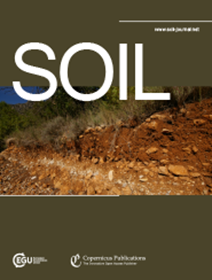Comparative efficacy of individually and combined application of compost, biochar, and bentonite on Ni dynamics in a calcareous soil
IF 4.3
2区 农林科学
Q1 SOIL SCIENCE
引用次数: 0
Abstract
Abstract. In Iran, a considerable proportion of agricultural soils are contaminated with various heavy metals (HMs), including nickel (Ni), necessitating remediation to mitigate their transfer into the food chain. However, there remains a scarcity of research on the effectiveness of applying organic and inorganic materials, either individually or in combination, for Ni immobilization in contaminated calcareous soils. To address this gap, an incubation experiment as completely randomized design with three replications was conducted to compare the effect of different soil amendments, either individually or combined (municipal solid waste compost (M), bentonite (B), municipal solid waste compost biochar (MB), M+B, MB+B, MB+M each applied at 2 % wt.) on Ni immobilization in a calcareous soil with three Ni contamination levels (0 (Ni0), 150 mg kg-1 (Ni1) and 300 mg kg-1 (Ni2). The study employed analytical techniques such as SEM-EDX, XRD, FTIR, sequential extraction, and DTPA-release kinetics to assess the efficiency of these amendments on stabilizing Ni in the soil. Elevating Ni levels from Ni0 to Ni2 increased Ni concentrations across all soil fractions, especially in Fe/Mn oxides (FeMnOx) and organic matter (OM). All amendments except M enhanced Ni immobilization by converting more labile fractions (WsEx, Car, FeMnOx) into residual (Res) form. While combined amendments were not more effective than single treatments, MB was the most efficient in stabilizing Ni. MB also exhibited the lowest 'a' and highest 'b' values attributed to the power function kinetics model, indicating superior Ni desorption reduction. These finding are likely due to its alkaline pH, ash content, and phosphorus content, which facilitate Ni precipitation. In contrast, M increased Ni desorption by raising its bioavailability (WsEx and Car fractions). The combined application of biochar (MB) with either bentonite (B) or compost (M) did not exhibit synergistic effects on the immobilization of Ni in the soil. In conclusion, the independent application of municipal solid waste-derived biochar appears to be a potentially effective amendment for enhancing Ni immobilization in contaminated calcareous soils.单独和组合施用堆肥、生物炭和膨润土对钙质土壤中镍动态的比较效果
摘要。在伊朗,相当大比例的农业土壤受到各种重金属(HMs)的污染,包括镍(Ni),需要采取补救措施,以减轻其向食物链的转移。然而,在污染的钙质土壤中单独或联合施用有机和无机材料固定镍的有效性研究仍然缺乏。为了解决这一差距,进行了一项完全随机设计的孵育试验,进行了三个重复,以比较不同土壤改良剂单独或联合使用(城市固体废物堆肥(M),膨润土(B),城市固体废物堆肥生物炭(MB), M+B, MB+B, MB+M各以2%重量施用)对镍在三种镍污染水平(0 (Ni0), 150 mg kg-1 (Ni1)和300 mg kg-1 (Ni2))的钙质土壤中的固定化效果。本研究采用SEM-EDX、XRD、FTIR、顺序萃取和dtpa释放动力学等分析技术来评估这些改进剂对稳定土壤中Ni的效率。将Ni水平从Ni0提高到Ni2会增加所有土壤组分的Ni浓度,特别是在Fe/Mn氧化物(FeMnOx)和有机物(OM)中。除M外,所有的修正都通过将更不稳定的组分(WsEx, Car, FeMnOx)转化为残余(Res)形式来增强Ni的固定化。虽然复合处理并不比单一处理更有效,但MB在稳定Ni方面最有效。在幂函数动力学模型下,MB具有最低的a值和最高的b值,表明其具有较好的Ni脱附还原效果。这些发现可能是由于其碱性pH值,灰分含量和磷含量,有利于镍的沉淀。相反,M通过提高其生物利用度(WsEx和Car分数)来增加Ni的脱附。生物炭(MB)与膨润土(B)或堆肥(M)配施对土壤中Ni的固定化没有增效作用。综上所述,城市生活垃圾衍生生物炭的独立应用似乎是一种潜在的有效的修正,以增强镍在污染的钙质土壤中的固定化。
本文章由计算机程序翻译,如有差异,请以英文原文为准。
求助全文
约1分钟内获得全文
求助全文
来源期刊

Soil
Agricultural and Biological Sciences-Soil Science
CiteScore
10.80
自引率
2.90%
发文量
44
审稿时长
30 weeks
期刊介绍:
SOIL is an international scientific journal dedicated to the publication and discussion of high-quality research in the field of soil system sciences.
SOIL is at the interface between the atmosphere, lithosphere, hydrosphere, and biosphere. SOIL publishes scientific research that contributes to understanding the soil system and its interaction with humans and the entire Earth system. The scope of the journal includes all topics that fall within the study of soil science as a discipline, with an emphasis on studies that integrate soil science with other sciences (hydrology, agronomy, socio-economics, health sciences, atmospheric sciences, etc.).
 求助内容:
求助内容: 应助结果提醒方式:
应助结果提醒方式:


